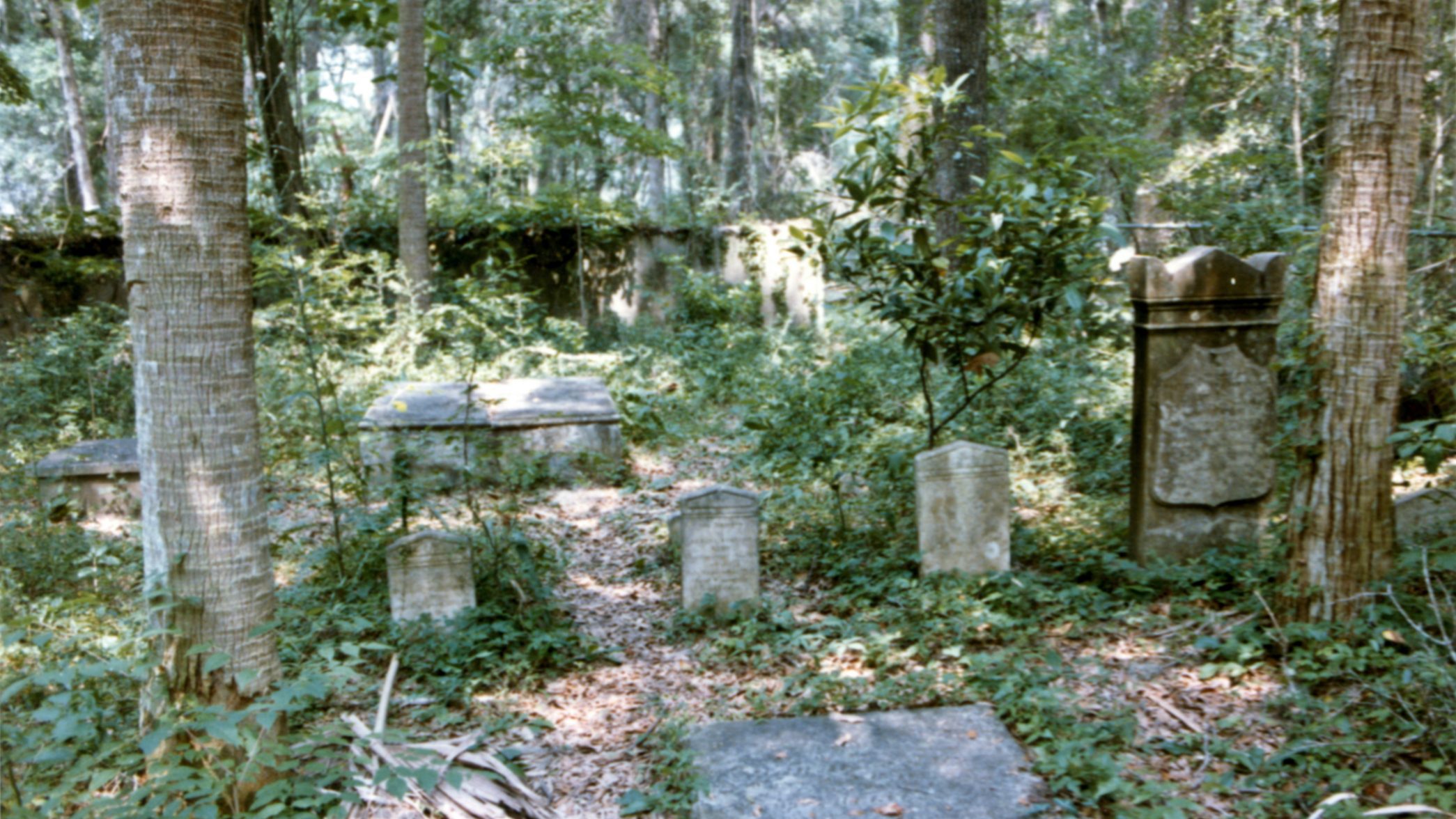Sams Family Cemetery (looking east) in 1983, the year ALCOA bought Dataw Island.
What you see in the old picture above is the Sams Family Cemetery, as it existed when ALCOA first arrived on the island in the early 1980s. The slab at the bottom of the image is the top of Sarah (Fripp) Sams (1789 – 1825) crypt. Unfortunately, we did not know that at the time because we were unaware of the drawings of the cemetery done in 1870 by Paul Brodie.
Sixteen years ago, the Dataw Historic Foundation began an effort to repair and preserve the brick wall around the cemetery, believed to be built in 1833 when the chapel was built. Since this involved digging at the wall, the DHF contracted for a ground-penetrating radar survey to ensure we would not disturb any graves. This effort led to the discovery of several buried pieces of marble, and the adventure began.
This is the story of the final resting place of Sarah (Fripp) Sams, the first wife of Lewis Reeve Sams (1784 – 1856). Until 2006, her grave was covered with a slab engraved with an epitaph, as shown in the 1983 photo above. But, unfortunately, that was not what her husband intended.
Sarah Fripp Sams (1789 – 1825)
Sarah was the first daughter born to Thomas Fripp (1761 – ?) and his wife Martha Hann (1765 – 1799). I am not sure where Sarah was born, but their other three children were all born on St Helena Island, so I assumed she was also. The Fripp dynasty comprised one of the most prominent plantation clans in the Sea Island area, particularly on Saint Helena Island, during the antebellum period [Rosengarten]. About 1809, at age 20, Sarah Fripp married Lewis Reeve Sams; she bore him eight children between 1810 and 1823. Unfortunately, we do not have a good portrait of her.
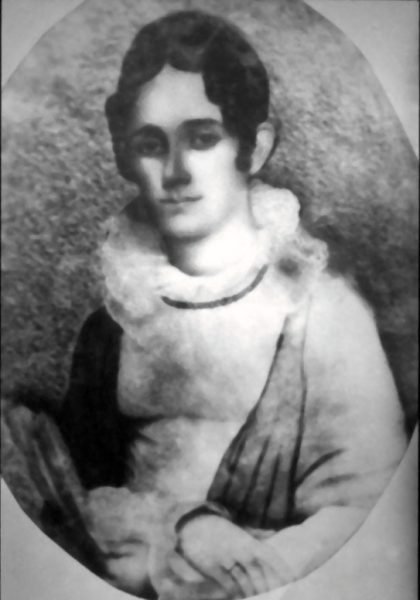
The earliest first-person record of her gravesite is from Conway Whittle Sams (see the article on Horace Hann Sams.) In his unpublished history of the Sams and Whittle Families, he says, “While on a visit to Datha, Dec. 5th, 1903, I took down the inscriptions on all of the tombstones in the family cemetery there.”
On his list is this epitaph for Sarah F. Sams,
Sacred to the Memory of Sarah Sams, a member of the Baptist Church, the wife of Lewis Reeve Sams, and the mother of Lewis Reeve, Miles Brewton, Angerona Hext, Caroline Edings, Robert Barnwell, Stanhope Augustus, Marion Washington, and Sarah Emily Sams, who was born Dec. 26th, A.D. 1789, and died Aug. 12, A.D. 1825. Aged 35 yrs., two months, and 17 days. Blessed are the dead who die in the Lord.
Conway does not comment on the state of the tombstones, whether erect or not, whether whole or broken. However, since the earliest days of Alcoa’s development of Dataw, past DHF members can remember a slab lying on the ground in the cemetery with the inscription above.
In preservation work by the Dataw Historic Foundation (2005 – 2010), the true nature of Sarah Fripp Sams’ grave was revealed by the old, the new, the archaeologist, and the stonemason.
The Old
Several drawings of the Sams Family Cemetery have been circulated over the last 20 years. One shows the chapel, built in 1833, from a distance, and another is of the interior. The third shows the graveyard. In the past, these had been incorrectly attributed in both artist and period. We know now, having viewed the originals which belong to Ting (Sams) Colquhoun, that Paul Brodie drew them. He was a Union soldier who returned to the area after the Civil War and opened an architectural business in Beaufort. He drew the graveyard in 1870.
The graveyard drawing (below) shows a crypt in the approximate location of the slab inscribed for Sarah (Fripp) Sams. (I took this photograph of Brodie’s original graveyard drawing in 2018 when Joe Roney and I visited Ting S. Colquhoun at her home in Beaufort, S.C. A professionally restored image is displayed in the DHF History & Learning Center on Dataw Island.)
I generally use the terms cemetery and graveyard interchangeably here. The graveyard is the preferred term when colocated with a church, as in the Brodie sketch. But the Sams’ chapel is now just a tabby ruin, so either term seems appropriate.
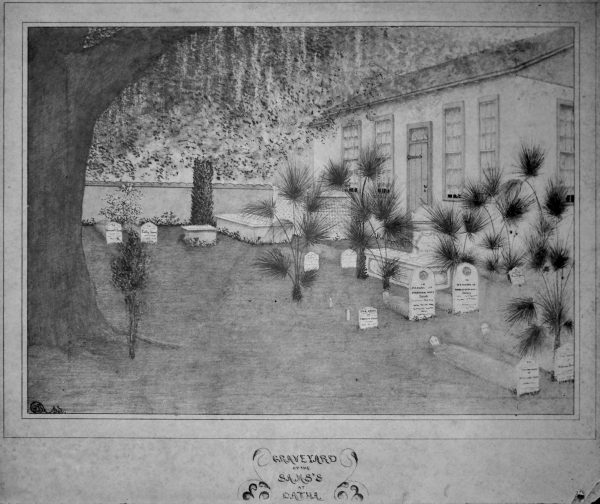
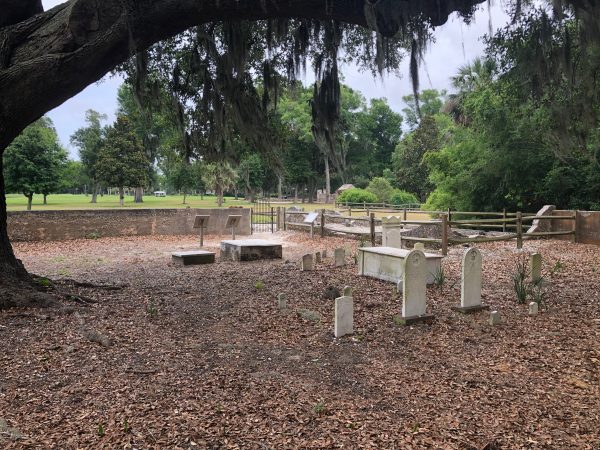
Little remains today of the chapel built in 1833, seen in the left photo. Fortunately, many early 19th-century headstones (and footstones) remain intact. And now, Sarah’s crypt is too.
The New
In March of 2005, a series of preservation projects began under DHF president Cathy Crocker and continued when Jack Brown took over as president. The first step was a Ground Penetrating Radar (GPR) survey of the two cemeteries and part of the plantation ruins area. In the Sams Family Cemetery at that time, the graves of 16 people had headstones, though previous research had mentioned three others buried here. Excitement grew when the GPR results, done under the leadership of Senior Archaeologist Dr. Eric Poplin of Brockington and Associates, revealed there were more gravesites in the cemetery. Also, he and his team found several pieces of marble buried near the southwest cemetery wall as work began to stabilize the entire wall around the Sams Family Cemetery.
As a short sidenote, the GPR results and other evidence confirmed two of the three gravesites (see The Story of One Southern Family.) However, there are possibly eight more unmarked graves in the Sams’ Family Cemetery.
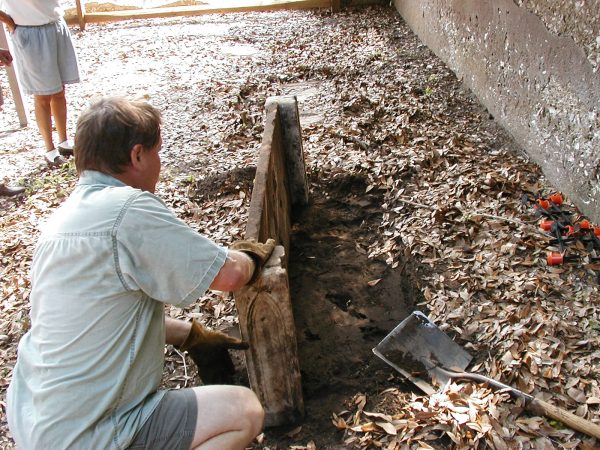
The Archaeologist
By the summer of 2006, archaeologist Dr. Eric Poplin had pieced the research and evidence together to draw this conclusion,
…the fragments are pieces of a crypt that once stood above the grave of Sarah Sams. The dimensions of the slabs, the square posts, the mortices in the posts and the mortices in the marble slab that lie beneath the engraved marker, all suggest that these pieces represent fragments of the same structure…. Given the similarity of the elements of this crypt to the one in the St. Helena Church Yard, it is unlikely that the remains of Sarah Sams were placed within the tomb. Most likely, she was buried in a grave atop which the marble crypt was then erected…
Cathy Crocker began writing a series of articles in the DHF Tabby Tattler about these evolving results and what to do with the pieces. Unfortunately, all the parts of the crypt could not be found, making it difficult to determine what to do next.
We send the DHF Tabby Tattler/Times to several Sams descendants around the United States. For example, Arthur Raoul Sams, Jr. (1913 – 2014) of Charlotte, N.C., read about the crypt story in a 2006 Tabby Tattler issue and contacted DHF to say he had been holding on to two other crypt pieces for 50 years! His daughter Susan Sams Allen presented the donated items to the DHF in 2007. With only one part of the crypt missing, the DHF began looking for a professional who could make the missing piece and reassemble the entire vault.
The Stonemason
We found a stonemason based in Virginia, David Via. He came down and spent a fair amount of time enjoying the Lowcountry, talking to Dataw folks about his craft, getting the missing piece crafted, cracks fixed, and the crypt reassembled in its original location over Sarah (Fripp) Sams’ grave. The local Sams descendants attended a graveside ceremony in April 2010 to celebrate the completion of this long and challenging project.
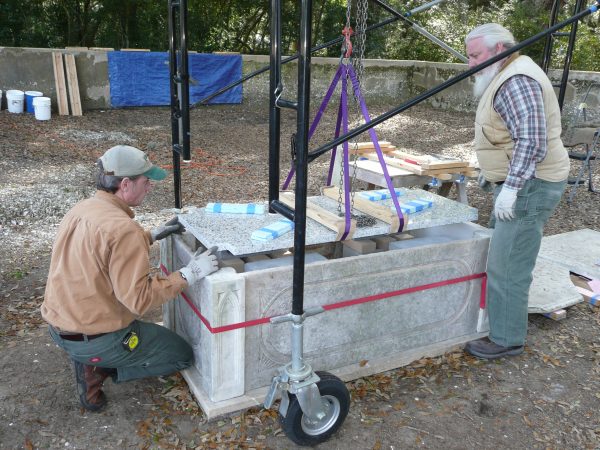
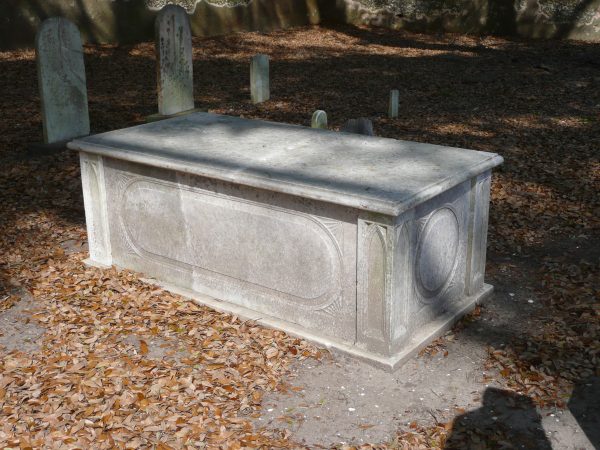
When you look across the Sams’ Family Cemetery below and realize that Sarah’s crypt was one of the earliest gravesites, its elegance is striking. Only her tomb and the two infants buried near the foot of her crypt (son and daughter of BB and Elizabeth Sams) would have appeared in the photo below in 1825; all the other headstones you see came later. It certainly seems that Lewis Reeve Sams deeply loved his wife since he commissioned this elegant temple to honor Sarah’s eternal resting place. In addition, though he had six children at her death, it would be another ten years before he remarried.
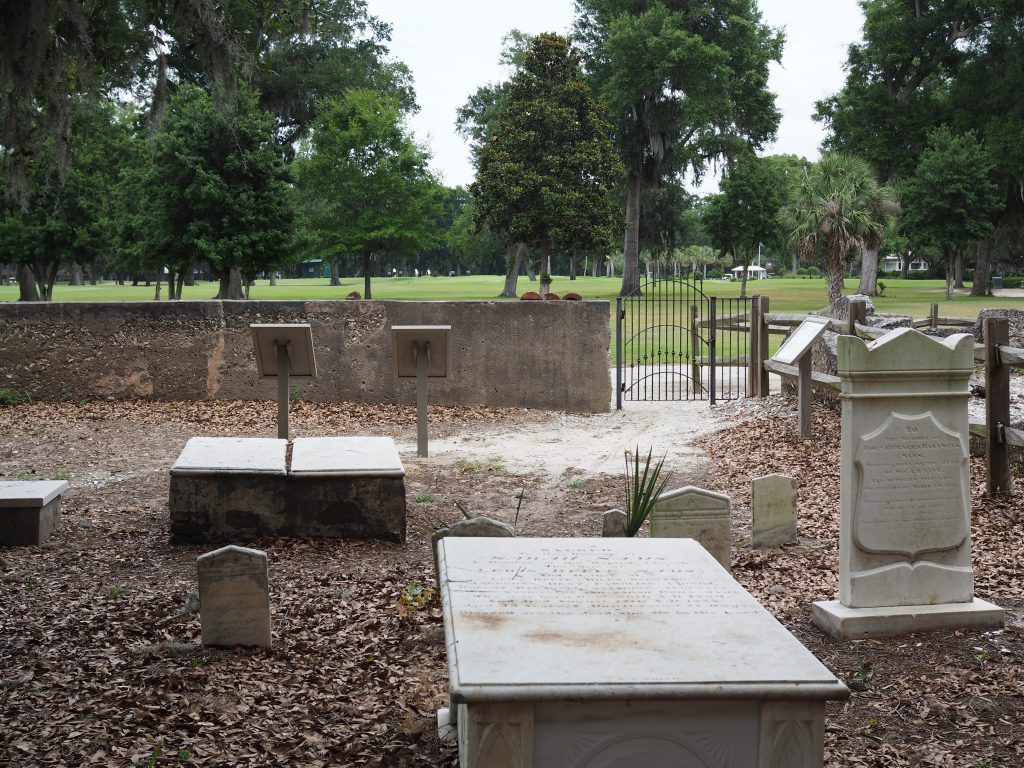
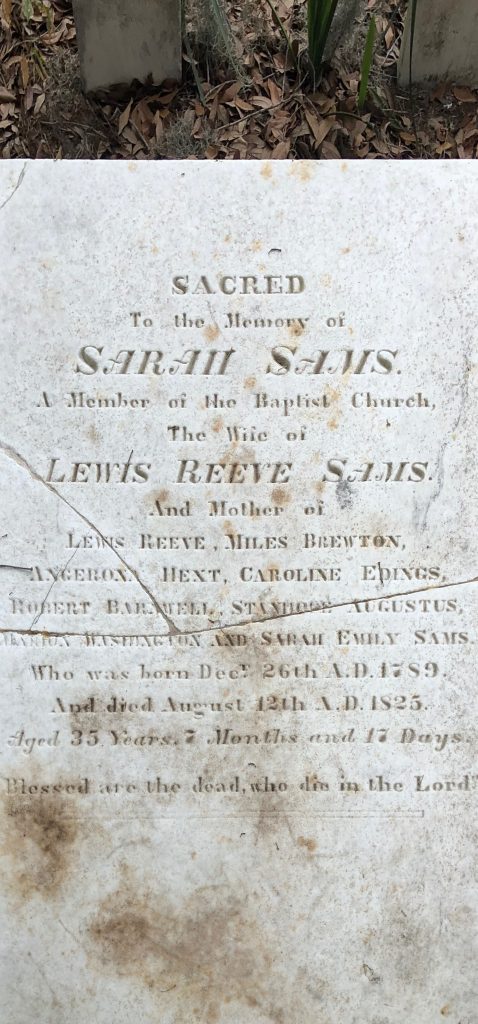
Sources
Dataw Historic Foundation, Tabby Tattlers, 2006 (Spring & Fall issues), 2007 (Fall issue), 2009 (Winter issue), and 2010 (Summer issue)
Poplin, Eric C. – Recent Archaeological Investigations in the Sams Family Cemetery, Dataw Island, South Carolina, Brockington Cultural Resources Consulting, September 2006
Rosengarten, Theodore –Tombee: Portrait of a Cotton Planter, 1986
Rowland, Lawrence S., Moore, Alexander, Rogers Jr., George C. – The History of Beaufort County, South Carolina, Volume I, 1514 – 1861, 1996
Sams, Conway Whittle – History of the Sams and Whittle Families, unpublished, circa 1925


